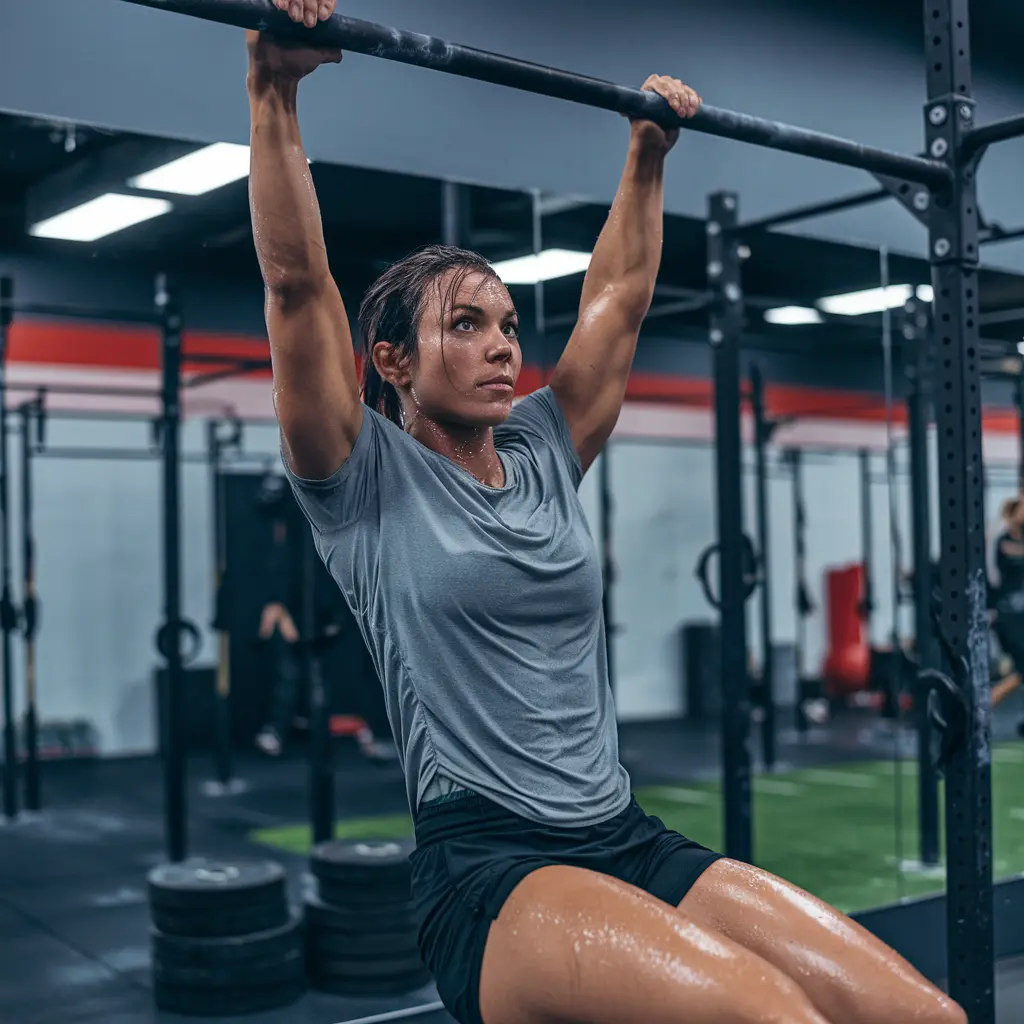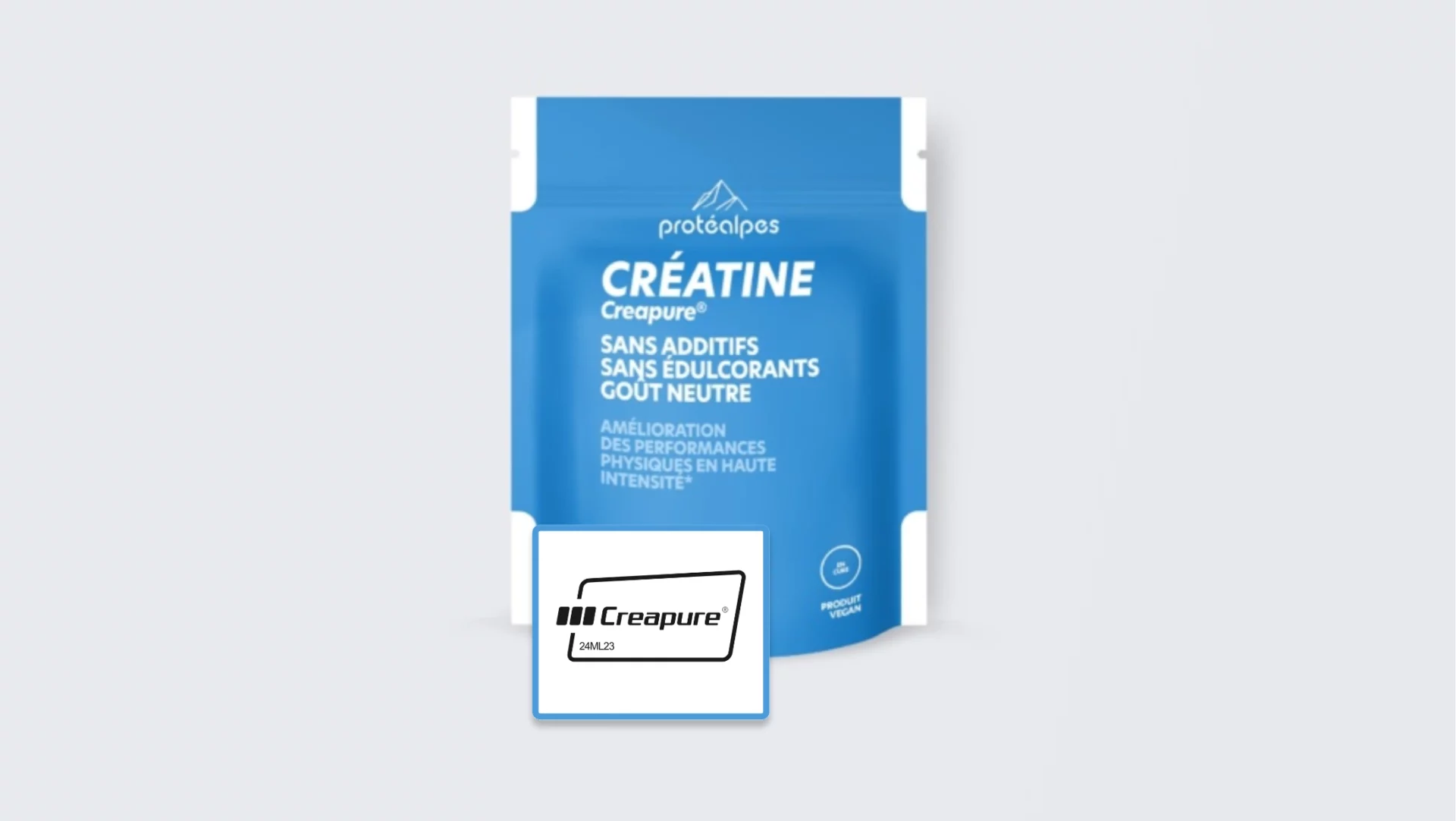Creatine raises many questions and fuels debate in the world of fitness and bodybuilding. Should you take it? Is it safe, and is it suitable for both men and women? One of the most frequently asked questions is: is creatine a steroid? Let's get to the bottom of this myth.
Contrary to popular belief, creatine is a substance that our body produces naturally. Its function in the muscular mechanism makes it an ally of short, intense sports. Yet it is often accused of causing water retention or stomach pains after high-dose consumption, and is even compared to the most dangerous anabolics.
Where does the confusion between the two substances come from? A close link in the manufacturing chain, when creatine is not pure, but not exclusively. From healthy doses of creatine to the harmful role of doping products, we explain the reality behind this supplement.
Contents
Understanding creatine's role in the body
What is creatine?
This natural substance is a 3-amino acid oligopeptide. It is synthesized by the body in the liver, kidneys and pancreas to the tune of 1g/day.
It is also present in thediet(meat, fish, very low doses in eggs, creatine monohydrate supplements).
Once in the body, free creatine is converted in the muscle into creatine phosphate.
This is known as an ergogenic aid.
By this we mean that it serves either to improve sports performance capabilities, or to promote adaptation to training. The emphasis on the term " capacity-enhancing " is a reminder that an ergogenic aid does not do everything on its own, and that without appropriate training, it is useless.
Studies on creatine have proven its positive ergogeniceffects1 and they have nothing to do with the harmful effects of anabolic steroids. Anabolic steroids disrupt natural energy circuits to stimulate protein synthesis.
This is the first major difference between the two.
Its role in muscle metabolism
Following the transformation of creatine in the muscle, phosphocreatine helps regenerate adenosine triphosphate. Better known as ATP, this energy fuel is essential for physical effort.
More phosphocreatine in the muscles means more ATP production, and hence greater efficiency.
This is especially true for short, intense efforts, because of the energy pathway used during these exercises.
To put it simply, muscle cells need ATP, and must immediately renew this energy to continue the effort. The pathways for ATP synthesis are called energy metabolisms, of which there are three:
- alactic anaerobia;
- lactic anaerobia;
- aerobia.
Each energy pathway has its preferred substrate:
- creatine phosphate foralactic anaerobics;
- glycogen and glucose for lactic anaerobics;
- lipids and carbohydrates for aerobics.
The three pathways have very different autonomies, outputs and capacities. They overlap and take turns depending on theintensity of the effort.
In the case of short, intense workouts, the focus is more on anaerobic alactic conditions, hence the interesting effect of creatine on power workouts that combine strength and speed.
A more recent study also indicates that a course of creatine monohydrate, combined with a resistance training program, increases intramuscular IGF-1² concentration. This polypeptide hormone has an anabolic action similar to that of growth hormone.

Why is creatine often mistaken for a steroid?
Anabolic steroids: what are we talking about?
The World Anti-Doping Agency (WADA) prohibition list includes 14 classes, the very first of which concerns anabolic agents.
These include :
- Anabolic androgenic steroids (known as AAS) are exogenous, i.e. produced outside the body. This is the case with clostebol, for example, which is not produced naturally by the human body, but is used for doping purposes for its anabolic properties.
- Endogenous AAS, i.e. produced by the body but administered exogenously. This is the case with testosterone, for example, which is initially natural, but which some people also administer exogenously.
- Other so-called anabolic agents, which stimulate other receptors but share the same anabolic properties. This is the case with clenbuterol, a product originally reserved for animals, but which some people are misusing, with all the dangers that entails.
These doping substances are manufactured to mimic testosterone, a so-called "male" sex hormone produced naturally in both men and women.
Their ingestion by cure gives 2 types of effects:
- Androgenic = accentuation of virilizing characteristics (increased hairiness, enlarged vocal cords, etc.);
- Anabolics = increase lean mass and muscle strength, reduce body fat, improve resistance to fatigue, increase aggressiveness, facilitate recovery.
Whether natural or not, anabolic substances are banned in all forms because they are dangerous.
Steroids VS creatine: different mechanisms of action
We're talking about two totally different mechanisms: one direct, the other indirect.
Steroids, coupled with resistance training, stimulate what is known as protein synthesis, i.e. they contribute to muscle growth.
How do they do this? Basically, testosterone penetrates muscle cells, binds to androgen receptors and increases gene expression inside the muscle. This is how muscle mass and strength are directly increased.
It does this much faster and better than years of rigorous training³, which explains why some athletes resort to doping products, despite the increased risks.
Creatine, for its part, acts on energy production within the muscle. Under the effect of an enzyme, creatine kinase, it becomes phosphocreatine and helps produce ATP, our fuel.
A creatine cure results in more ATP, and therefore more energy for short, intense workouts. The result: more muscular power and exercise volume, which contributes to hypertrophy, but indirectly and, above all, over a much longer period.
Gains are slightly higher than they would be without supplementation³. Even if it only represents a small plus in explosiveness or performance, creatine remains interesting for those seeking performance.
Different impact on the body
If we had to sum it up in one sentence: creatine is safe for the body, unlike anabolic steroids, which are very harmful to health.
Now, let's get into the details.
The Australian Institute of Sport rightly points out that there is no scientific evidence of adverse effects linked to creatine monohydrate supplementation. Yet creatine monohydrate has a bad reputation: sometimes it's claimed to cause kidney or stomach problems, sometimes it's accused of causing weight gain.
The opposite is true: studies even show that creatine has beneficial effects on the brain and plays a neuroprotective role. It is used, for example, in post-concussion medical protocols in rugby.

Steroids, on the other hand, are responsible for numerous side effects AND are dangerous to health:
- Short-term: aggressiveness (particularly roid rage), mood and behavior disorders, gynecomastia, acne, oligospaniomenorrhea (irregular menstruation), virilization, musculo-tendinous imbalance and possible tendon rupture;
- Medium-term: violent psychiatric consequences, depression, thrombo-embolic disorders, cardiovascular disorders, asthenia (fatigue), reduced libido and erectile dysfunction, addictions and withdrawal syndrome, suicide;
- Long-term : reduced testicular volume, oligospermia, hypofertility, cholestasis (liver disease), cancer, prostatic hypertrophy, cardiac hypertrophy.
As in the case of Pistorius, the athlete suspected of using steroids when he violently killed his girlfriend, the consequences of this form of doping are serious.
Some anabolic steroids can also promote hair loss. This is due to increased levels of dihydrotestosterone (DHT), a hormone derived from testosterone and implicated in androgenetic baldness. This risk is more pronounced in genetically predisposed individuals. Once again, the idea that creatine causes baldness stems from the steroid/creatine confusion.
Some of these effects are irreversible, even after you stop taking steroids, which is why you should never take them.
Why do some people still think creatine is a steroid?
Many people still believe that creatine is a doping product. The confusion persists for several reasons.
Firstly, because some athletes have tried to make people believe that they have gained enormous muscle just by taking creatine monohydrate. Others have already tested positive for steroids, while trying to make people believe that their performances were only linked to taking an authorized dietary supplement.
In 2017, according to the World Anti-Doping Agency (WADA) report, anabolic steroids accounted for 50% of positive tests.
Secondly, because creatine and steroids are closely linked in exercise physiology.
To put it simply, both act in the same energy pathway: alactic anaerobia.
In this case, the doping products affect the creatine-phosphate stock, which is used to regenerate ATP. And creatine, the source of phosphocreatine, optimizes the effects of anabolic steroids.
The last reason is also because France banned the distribution of creatine until 2006, for its supposedly harmful effects.
If we go back to the origins of its bad press, it is linked to :
- To the doping scandals of the 1990s, such as the Festina Affair;
- A 2001 report by the authorities on a supposed carcinogenic effect (since invalidated);
- Amalgamations over the use of creatine contaminated with steroids which led to positive tests where both products were blamed.
This is one of the reasons why we always recommend tracing the origin of products: to avoid contamination on the production line.
France is one of the last European countries to have changed its regulations on the substance, at the instigation of the European Union.
Creatine is therefore an authorized, healthy and legal product, which is far from being the case for steroids.
The weight of legislation surrounding steroids
Creatine and steroids are diametrically opposed in the international rankings as to their respective uses.
To illustrate:
- Classified as category S1.1 (SAA) on the WADA3 Prohibited List , steroids are permanently banned.
- Creatine, on the other hand, is not on the WADA list, but is classified in category A by the Australian Institute of Sport. This category groups together products with solid scientific evidence for safe use by athletes.
While creatine is a natural compound, steroids are drugs with a totally different chemical structure.
In the USA, the Food and Drug Administration (FDA) controls and classifies the two substances differently. While the possession and administration of steroids without a prescription is illegal, the ingestion of creatine does not, of course, carry any legal sanction.
In Europe, most countries also have very strict legislation on steroids.
France, for example, prohibits trafficking in doping substances and methods, incorporating the entire list of WADA bans. Selling, giving away, transporting, sending, delivering or distributing steroids is therefore illegal.
The Office Central de Lutte contre les Atteintes à l'Environnement et à la Santé Publique(OCLAESP by its French acronym) coordinates the various administrations involved (justice, customs, health, etc.).
In the event of an international doping system, it can act in concert with Interpol.
On the other hand, the sale and distribution of creatine in France is perfectly legal.
So there's a big gap between the two products, with major differences at every level.

Creatine's effects on performance and health
Creatine's effects on sports performance
It is a favorite among athletes and weightlifters seeking:
- to improve their sporting and physical performance;
- to optimize recovery time.
The effects of a creatine monohydrate cure are systematically seen on single and multiple series of short, intense physical activities. In swimming and athletics, for example, it gives you the edge when it comes to multiplying 50 m efforts.
With a bonus:systematic optimization of trainingadaptations . This means that the body evolves with training, and creatine will enhance the effects of this natural adaptation of the organism.
To achieve this, supplementation systematically increases intracellular creatine stores, which in turn boosts the cell's capacity to resynthesize ATP.
In practice, this translates into an increase in:
- maximum strength;
- maximum work output;
- energy production;
- sprint performance;
- lean body mass.
Its effects also affect recovery time between intense sets. How does it do this? By reducing protein degradation in the muscles and increasing recovery of strength production potential, reduced by effort.
That's why it can also be of interest during dry periods.
Creatine, a healthy product
There are many myths and preconceived ideas surrounding creatine, including:
- creatine makes you lose weight;
- it causes kidney disease;
- it causes hair loss;
- you need to drink more water.
While there are many stories to be told, none has been scientifically proven. So there's no risk in taking creatine monohydrate when you're in good health, as long as the product meets the necessary traceability and quality criteria.
Best practices for creatine supplementation: what you need to know
Who benefits from creatine?
Adolescents, adults, the elderly: creatine seems to benefit everyone.
Several studies show the effectiveness of creatine supplementation in adolescentathletes4.
21% of a sample of 270 high school students (boys - USA) admitted to having ever taken creatine (Kayton et al.), which explains why research has focused on this audience.
None of the numerous studies carried out on children and adolescents have demonstrated any deleterious effects from short- or long-term supplementation. Whether it's a question of kidneys, possible inflammation or liver problems, no marker has been able to demonstrate any effect.
One study even highlighted the benefits of a 6-month course of treatment for traumatic brain injury (Sakellaris et al.) in this population. Creatine would appear to be an asset for young athletes in collision-risk sports such as rugby.
That said, we do not recommend creatine for children and adolescents, especially before puberty. Although there is no risk involved, we don't consider this supplement to be necessary for these types of profiles.
For an older population, supplementation would also appear to be beneficial, particularly in reducing the impact of sarcopenia. This age-related pathology is characterized by muscle wasting, leading to possible falls, fractures and physical incapacity. Creatine intake improves the effect of resistance training.
Finally, creatine is also of interest to women. Wrongly associated with men and strength sports, creatine is also beneficial to women, in terms of physical performance and recovery. Appropriate supplementation is even useful at particular stages in their lives, such as the menopause.
How do I take creatine effectively?
Everyone can benefit from taking creatine, depending on their individual goals. Even so, there's no point in considering it without first looking after your diet and adapting your sports program.
Creatine is a supplement, and as its name suggests, it complements an appropriate, balanced diet.
It is taken 2 or 3 times a day, so you need to absorb 3 g daily, diluted in liquid and preferably accompanied by carbohydrates. A course of treatment lasts 1 to 1.5 months, with breaks of the same duration in between. A loading dose of 20 g per day (divided into 3/4 intakes), over 5 days, is useful for rapidly increasing endogenous creatine levels, before moving on to the 3 g maintenance dose.
Above all, we strongly advise you to choose your creatine carefully , to avoid contamination with other products such as anabolic steroids. Unfortunately, it's not uncommon to find steroids in products where they don't appear on the label. This is why the Creapure® label has been created. This guarantees that the product is pure, made in Germany, safe for your health and free from doping agents.
Conclusion
So, is creatine a steroid? Of course not! Creatine clearly differs from anabolic steroids, both in its effects on the body and in its mechanisms of action.
Unlike steroids, which directly influence protein synthesis to promote rapid, artificial mass gain, creatine acts indirectly. It boosts energy production for short, intense efforts. Creatine is an authorized supplement, naturally present in the body and without risk to health when consumed under appropriate conditions. It is neither a hormone nor a hormone derivative.
Despite popular belief, creatine is far from being a doping product, and offers invaluable support for sporting performance, without the deleterious effects of steroids. Steroids are extremely dangerous to health, and the list of serious and irreversible side effects is long. Conversely, the benefits of creatine can be enjoyed by people of all ages, men and women alike, including in the prevention of age-related muscle loss or during specific periods such as the menopause.
The only thing creatine and steroids have in common is their image associated with sports performance. For the rest, they don't meet the same needs or produce the same effects. Of the two, creatine is the winner and remains thesafe and effective ally for supporting sports performance.
Sources:
Further information
To clarify concepts that are often confused, this analysis of the difference between creatine and creatinine distinguishes a supplement used for performance from a biological marker used in blood analysis.
Whey and creatine: what are the differences?
BCAAs and creatines: what are the differences?
Should I take creatine on rest days?















